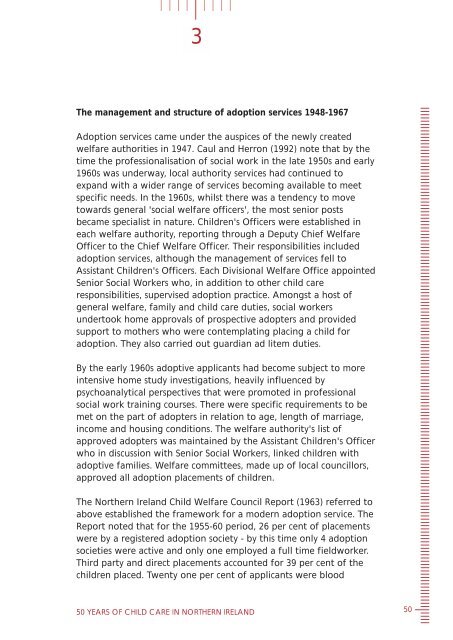childcare-50years
childcare-50years
childcare-50years
Create successful ePaper yourself
Turn your PDF publications into a flip-book with our unique Google optimized e-Paper software.
3<br />
The management and structure of adoption services 1948-1967<br />
Adoption services came under the auspices of the newly created<br />
welfare authorities in 1947. Caul and Herron (1992) note that by the<br />
time the professionalisation of social work in the late 1950s and early<br />
1960s was underway, local authority services had continued to<br />
expand with a wider range of services becoming available to meet<br />
specific needs. In the 1960s, whilst there was a tendency to move<br />
towards general 'social welfare officers', the most senior posts<br />
became specialist in nature. Children's Officers were established in<br />
each welfare authority, reporting through a Deputy Chief Welfare<br />
Officer to the Chief Welfare Officer. Their responsibilities included<br />
adoption services, although the management of services fell to<br />
Assistant Children's Officers. Each Divisional Welfare Office appointed<br />
Senior Social Workers who, in addition to other child care<br />
responsibilities, supervised adoption practice. Amongst a host of<br />
general welfare, family and child care duties, social workers<br />
undertook home approvals of prospective adopters and provided<br />
support to mothers who were contemplating placing a child for<br />
adoption. They also carried out guardian ad litem duties.<br />
By the early 1960s adoptive applicants had become subject to more<br />
intensive home study investigations, heavily influenced by<br />
psychoanalytical perspectives that were promoted in professional<br />
social work training courses. There were specific requirements to be<br />
met on the part of adopters in relation to age, length of marriage,<br />
income and housing conditions. The welfare authority's list of<br />
approved adopters was maintained by the Assistant Children's Officer<br />
who in discussion with Senior Social Workers, linked children with<br />
adoptive families. Welfare committees, made up of local councillors,<br />
approved all adoption placements of children.<br />
The Northern Ireland Child Welfare Council Report (1963) referred to<br />
above established the framework for a modern adoption service. The<br />
Report noted that for the 1955-60 period, 26 per cent of placements<br />
were by a registered adoption society - by this time only 4 adoption<br />
societies were active and only one employed a full time fieldworker.<br />
Third party and direct placements accounted for 39 per cent of the<br />
children placed. Twenty one per cent of applicants were blood<br />
50 YEARS OF CHILD CARE IN NORTHERN IRELAND<br />
50


